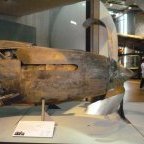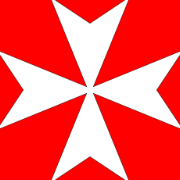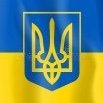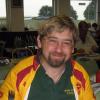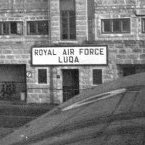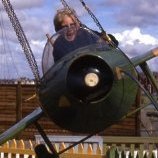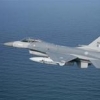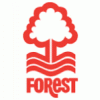Search the Community
Showing results for tags 'Junkers'.
-
MikroMir is to release a 1/48th Junkers F.13 kit - ref. 48-021 Source: https://www.facebook.com/mikro.mir.dnepr/posts/3245837238827323 First 3D renders V.P.
-
Hello guys, as per the title, does anyone have any building tips for Revell's Ju 88A-1 in 1:32? Especially around the cockpit area. My first attempt at this model ended up with horrible gaps around the nose and cockpit area. With the second model, I learnt from my mistakes and managed to evade any issues with the cockpit. Sadly I had to trash the model after a shelf fell over it. Now, this will be my third attempt to build this plane, and I would like to receive some building tips. I plan on finishing this third model as my second one, B3+DR from KG54. Any building tips will be helpful, especially any tips regarding the fit of the cockpit and the sidewalls to the fuselage halves. I already have SAC's white metal landing gear to replace the plastic ones from the kit. Thank you very much, Francisco.
- 14 replies
-
- 1
-

-
- Ju 88 1:32
- Junkers
-
(and 1 more)
Tagged with:
-
MikroMir is to release a 1/72nd Junkers Ju-388 kit. Source: https://www.facebook.com/mikro.mir.dnepr/posts/4646701468740886 Renders in progress V.P.
- 24 replies
-
- 9
-

-

-
Ju.88A-4 w/German Personnel & Torpedo Trailers (48229) 1:48 ICM via H G Hannants Ltd The Ju-88 was designed as a schnellbomber in the mid-30s, and at the time it was faster than current fighter designs, so it was projected that it could infiltrate, bomb and exfiltrate without being intercepted. That was the theory anyway. By the time WWII began in the west, fighters had caught up with the previously untouchable speed of the 88, and it needed escorting to protect it from its Merlin equipped opponents. It turned out to be a jack of all trades however, and was as competent as a night fighter, dive bomber or doing reconnaissance as it was bombing Britain. They even installed a big gun in the nose and sent it against tanks and bombers, with variable success. The A series was powered by a pair of Jumo 211 engines with annular radiators in cylindrical cowlings producing over 1,000hp each, and was improved gradually up until the A-17, with the A-4 a general improvement from previous versions, including a longer wingspan, more powerful engines, and more potent self-defence weapons. It also benefited from stronger landing gear to cope with the weapons that could be loaded onto the stations under the inner wing panels. The Kit This is a new variation on the original tooling of an A-series airframe that was release recently by ICM, with new parts added to make it version specific to the A-4, and adding a separate torpedo, trailer and a set of crew figures to place around the finished model. The box is the usual top-opening with an inner lid style, and inside you will find twelve sprues in grey styrene, one in clear, decal sheet and a glossy covered instruction booklet with spot colour inside, and the decal options in full colour on the back cover, plus two additional sheets for the figures and the trolley. If you have been lucky enough to see the other boxings, you'll know that detail is right up there in terms of quality and crispness, with ICM really improving over the last few years, which has been great news for modellers, as they aren't frightened of tackling what to us may seem niche subject matters. Construction begins with the fuselage, installing the sidewall detail inserts in the capacious cockpit area, along with some dial decals to bring out the detail. Rear bulkhead, side consoles with decals and a crew seat are all added to the cockpit sides rather than the floor for a change, with an insert in the fuselage for the circular antenna and tail wheel added into the starboard side. The instrument panel is supplied with a decal, and fits into the front of the cockpit opening during fuselage closure. The missing floor is added to the lower fuselage panel that includes the lower inner wings and gives the structure some strength. It also receives the rudder pedals, control column, and the two remaining crew seats back-to-back before being joined to the fuselage from below. The tail plane has articulated flying surfaces that can be installed without glue during closure of the fins, and the wings are supplied as top and bottom, with the flaps and ailerons separate from the box, and neat curved fairings so they look good when fitted deflected. The flaps include the rear section of the soon-to-be-fitted nacelles, which are added as separate parts to avoid sink-marks, and these and the ailerons run full-span, terminating just as the wingtip begins. This variant was fitted with the under-fuselage gondola, and each side has separate glazing panels inserted from inside, and a seam running vertically through its length, fitting the lower glazing after joining the two halves. It is added to the hole in the underside of the fuselage, with the front and rear glazing plus zwilling mounted machine guns later in the build. The landing gear is made up on a pair of upstands that are added to the underwing in preparation for the installation of the nacelle cowlings. The engines must be built up first though, made from of a high part count with plenty of detail, and a rear firewall that securely fits inside the cowling. Even though this is an in-line engine with a V-shaped piston layout, the addition of the annular radiators gives it the look of a radial, with their representation added to the front of the cowling, obscuring much of the engine detail. The cooling gills around the cowling are separate, and the exhausts have separate stacks, which aren't hollow but are large enough to make reaming them out with a drill a possibility, with optional semi-cylindrical flame hiders that fit over them. The completed nacelles fit to the underwing over the top of the main gear installation, securing in place with four pegs, two on each side of each nacelle. The props are made from spinner, backplate and a single piece containing all three blades, sliding onto the axle projecting from the engine front, which will require some glue if you want to keep them on. At this point the instructions recommend adding the canopy glazing, which consists of a faceted nose cone, and the main greenhouse for the cockpit aperture, with a forward firing machine gun pushed through a hole in the windscreen. The rear portion is made from two additional parts due to its double "blown" shape to accommodate the two rearward gun positions, so that the gunner's head isn't constantly pressed against the canopy, spoiling his situational awareness. The guns are fitted through the two circular ports on the rear, although no ammo feed is supplied. Under the wings the two torpedo crutches on aerodynamic mounts are glued, with the torpedoes made up from halves with separate props and fins, along with the fairings that fit between the pylons and fuselage sides. While the airframe is flipped over, the two-part wheels and twin main gear bay doors are added, both having good detail and the former a radial tread. Addition of the canopy mounted antenna completes the build, but this is likely to be done long after main painting for safety's sake. Torpedo & Trailer (48404) This set is contained on a single sprue of grey styrene that contains parts for a complete torpedo, plus a trailer to transport it around the airfield. The trailer is made first, with six cross-members installed on a cruciform chassis and fleshed out with a set of tubular frames and sections of tread-plate on either side of where the torpedo will sit. A pair of wheels glue to the short ends of the crucifix, then the torpedo is built from two halves with a double row of blades on the screw and a pair of perpendicular fins at the rear. The break-off tail is made from two T-shaped end panels, with four vanes stretched between them. The wooden tail slots over the torpedo’s fins, and the finished weapon is lowered into the cradle running along the trailer’s direction of travel. There are two colour options for the torpedo, which varies only in the colour of the empennage around the screw at the rear. German Luftwaffe Ground Personnel (48084) This extensive set is supplied on one sprue that contains seven figures, plus a dog. There are three officer-types, one carrying a briefcase, another a walking cane, while the third, a pilot-type is holding one hand out in askance of an unknown question, with the other hand on his hip. The maintenance crew includes a gentleman standing over the others with hands on hips, while two spanner-twirlers discuss a repair, one with screwdriver in hand. The last figure is sitting on an imaginary wheel, finishing off his lunch by offering the last part of it to a dog, while he holds his plate/bowl in his opposite hand. The dog is working for his/her living, raising a paw to solicit the tasty morsel from the mechanic. It’s of an indeterminate “mutt” breed with pricked ears and a brush tail that would probably be working overtime if the figures were animated. A greyscale set of drawings of the figures on the rear of the instruction sheet covers both the parts and colour call-outs, both referring to the parts diagram and colour table on the opposite side. The colours are given in Model Master and AKAN shades as well as the names in English and Ukrainian, as the kit was originally released before ICM’s own paint system was available. Markings The kit includes four markings options from the relevant theatre, and the first page of the painting section details the application of the numerous stencils that are supplied with the kit. There are no Swastikas on the sheet, but the Balkenkreuz are included, and if you’re struggling for historical accuracy and they’re permitted in your territory, you can always buy them separately. From the box you can build one of the following: 8./KG26, Grosseto, Italy, late 1942 1./KG77, Italy, September 1943 7./KG77, Orange-Karitat, Southern France, April 1944 3./KG26, Bardufoss, Norway, February 1945 The colours are picked out using letters that correspond to a table on the front page, which gives the names and paint codes in Revell and Tamiya ranges, so should be easy to convert to your paint system of choice. The decals have good register, colour density and sharpness, with additional instrument dials included on a clear carrier film to help with cockpit painting. The stencils are all legible, and they inspire confidence, with a thin carrier film cut close to the printing, with a few exceptions where lettering has film that could have been dispensed with to reduce the menace of silvering. Applying them to a gloss surface is the most reliable way to reduce silvering however. Conclusion ICM's expanding modern range of Ju.88s, Do.17s and other types are a good example of how far they have come in recent years, adding value to their brand, and improving their reputation with each release. The kit is well-detailed and comprehensive in what it includes, and with a nice quartet of decal options that say "build me", coupled with the figures and the extra torpedo on a trolley, it’s great value. Highly recommended. Available in the UK from importers H G Hannants Ltd. Review sample courtesy of
-
Master-X has released 1/72nd Junkers W.33 resin kits - ref. 7215.01 - Junkers W.33he - BO+GC Source: http://www.master-x.wz.cz/W33_BO_GC.html - ref. 7215.02 - Junkers W.33he - DK-AM Source: http://www.master-x.wz.cz/W33_DK_AM.html µ - ref. 7215.03 - Junkers W.33he - D-OPIQ Source: http://www.master-x.wz.cz/W33_D-OPIQ.html - ref. 7215.04 - Junkers W.33he - D-OHYF Source: http://www.master-x.wz.cz/W33_D-OHYF.html - ref. 7215.05 - Junkers W.33he - BB+GH Source: http://www.master-x.wz.cz/W33_BBGH.html - ref. 7215.06 - Junkers W.33he - D-2757 "Horst Wessel" Source: http://www.master-x.wz.cz/W33_Horst_Wessel.html V.P.
-
-
Stencil Decals for Ju.87 Stuka (D48106 for Hasegawa/Airfix/Italeri) 1:48 Eduard Decals Eduard’s stencil range has been growing steadily of late, providing sharp, detailed stencilling for numerous types, some of which are lacking from the originating manufacturer’s box. The latter can come in handy for your average modeller, as sometimes the kit doesn’t include a complete set of stencils for expediency or whatever reason. Some folks, myself included, think that the inclusion of a full suite of stencils adds extra realism to a model, although there is of course the time element and the extra carrier film edges to hide. Eduard have been busy of late and have released this comprehensive set we have to review. It arrives in a clear foil re-sealable envelope with a card stiffener, a cover page with instructions, plus the decals with wax paper protecting the delicate printed surface. This set arrives on one sheet, and is patterned for almost any 1:48 Stuka due to the generic nature and placement of the stencils. Over the course of four profiles from overhead, underneath, and the sides, plus a diagram of the prop from the front, the locations of all the stencils are shown clearly on greyscale line drawings that use coloured arrows and numbers to differentiate from the background. Link to PDF of instructions. The decals are printed in-house by Eduard and have good register, sharpness and colour density, with a glossy carrier film printed close to the edges of the printed areas. Don’t forget that as of 2021, the carrier film from Eduard decals can be coaxed away from the printed part of the decal after they have been applied, effectively rendering them carrier-free, making the decals much thinner and more realistic, and obviating the need to apply successive coats of clear varnish to hide the edges of the film. It’s a great step further in realism from my point of view. Highly recommended. Review sample courtesy of
-
Ok the idea for this build is a bit of a mash up of a couple of builds I have wanted to do, but didn’t the time or the motivation for at the time. One has been running around in one form or another in my mind for quite a while now. I have come close a couple of times to starting it, (a Ho-229 was to be the base for one) and I sort of did with the Turbo-Prop Arado, but it still wasn’t quite what I had in mind. I have two similar projects on the go but they're on the back burner for a bit. The second was that I have a Planet Models Ju-388J nightfighter (Jumo 213 version) sitting in the stash that I have been dying to build and have never had the excuse to. So after seeing the Ju-88 STGB I finally had the idea of how to killer two birds with one stone and bring these two ideas together! So the plan is…… If the war had stretched into 1946 we would have seen some interesting aircraft and technologies in service, especially so with radar technology advancing as quick as is was. By the end of the war we were already seeing the next generation of radar systems which operated in the Centimetre band, like the RAF’s H2S and US H2X radars and the German FuG-240 (Berlin) & FuG-244 (Bremen) units. A few of the Ju-88’s were fitted with the FuG-240 and it was found they recovered their original speed which had been lost with the earlier radar units and their large antennas/antlers! It would have been only to be a matter of time before the use of the FuG-240 (and later versions) would have been more widespread, with it being fitted to newer aircraft models as they became available. With the venerable Ju-88 reaching it’s peak in the Ju-388 family this aircraft would have been a prime candidate for the new radar system. Well that’s the plan, chop the nose off a 388 and fit a new nose, simple really, but……….. I want it to be as believable as possible and not too whiffy which will make it a bit harder. So this will be the base, Planet Models Ju-388J-3 with Jumo 213 engines, of cause I reserve the right to add lots of other stuff as I go along, it wouldn’t a normal build if I didn’t throw in heaps of extras! The 388 is actually quite a nice model the only thing that may give me issues is the wings, they are very slightly warped and getting the dihedral right will be fun! The nose is just a resin cast of the long radome version, it looks a bit better in my opinion than the shorter version. Well best to start by cutting off the nose, luckily there is a very convenient panel line to follow for this. Strangely enough this happens to be almost perfectly round which will make life much easier as we go to fit the nose. Ok first fit, it doesn’t look all the great, I’ll need to move it forward a bit. That’s looking a bit better, so I’m going to have to add a bit to get the profiles right, I have a plan for that! First I’ll make a ring using plastic card, working with plastic will make this part so much easier! Next to fill the gap I’m going to use plastic strip like so. I just keep adding rings till I get the right diameter. Then add a disk at the back the size I require and the first part is done, only a small amount of filler required for shaping. Ignoring the joint gap for the moment I now have to decide how I want the new nose to sit, sort of inline with the horizontal axis or a bit dropped down? I like the inline one as it looks good, but I have to remember the flying attitude of the 388 (and 88 for that matter) was slightly nose up, they didn’t fly truly level! So I may need to have it slightly drooped down so the antenna face would be lined up to the vertical axis. Have a look at how the antennas were mounted on 88’s and you’ll see what I mean. Well I’ve made a start, there’s only a couple of hours work (I needed a brake from the Ta-152 as I was getting annoyed with it!) and the project is a goer. I’ve actually done the filling of the nose now as well and it’s looking good! This won’t be a full time project, just something to work on when my other builds frustrate me and I need a break from them. I can’t promise I’ll be finished by Xmas either as I’m bound to do other mods on this as I go along. This should be an interesting build!
- 14 replies
-
- 11
-

-
MikroMir is to release a family of 1/48th Junkers W.34, W.33, W.46 & K.43 Source: https://www.facebook.com/mikro.mir.dnepr/posts/3208785395865841 First 3D renders V.P.
-
Ju-87G1/G2 Stuka (BF-002) 1:35 Border Model via Albion Alloys The Stuka must be one of the most well-known German aircraft of WWII, partially because of its propaganda effects during the Nazis’ early successes with Blitzkrieg as they over-ran much of Europe, one after another. It was developed in the mid-30s as a dive-bomber, with distinctive gull-wing and fixed undercarriage with spatted wheels, which housed the so-called ‘Jericho Trumpet’ sirens that terrified its victims, knowing that the bombers were entering the dive phase of their attack from an almost vertical angle. The pilots would often black-out during the dive, but they were assisted by an automatic pull-out system that prevented many pilots from ploughing into the ground whilst unconscious. When they were used to attack the British Isles they experienced heavy losses due to the fact that they were preyed upon by a faster, more agile opponent, and those fighters were being accurately directed toward them by radar operated ground-control. They began to be used in conjunction with Bf.110 escorts, but even the 110s were no match, needing their own escorts against the British Spitfires and Hurricanes. Rather than withdrawing the type from service entirely, they worked upon improving the airframe, and re-tasked it for other roles in less dangerous environments where the fighter opponents were either absent or less capable than the typical Allied aircraft of the day. The initial Ju.87B that was so badly mauled by the RAF gave way to the C, the D, and finally the R, which included a pivot to the ground-attack and tank destroyer role in which it had mixed success, partly due to its relatively slow speed over the battlefield making it an easy target. It lost the ground-attack role to the Fw.190, ending production of the type at the close of 1944, by which time it was hopelessly outclassed. The Kit This is a brand-new tooling from Border models from their new line of 1:35 aircraft that began with the Bf.109 that we reviewed here a while ago. It arrives in a large top-opening box, and inside are five sprues of medium grey styrene, two sprues of clear parts, a small fret of Photo-Etch (PE) brass, a four-part resin figure, a decal sheet, and the glossy instruction booklet, with colour profiles on the back pages that have been penned for them by AMMO. Detail is very good, and once you get over the slightly unusual scale of things, especially the pilot, who appears too tall for the scale, but that’s an optical illusion from staring at 1:32 pilot figures for years. Measuring it, the fellow scales out at approximately 5’10” ignoring the extra height of his cap. Construction begins with the Jumo 211J engine that could output up to 1,400hp on a good day, and this starts with the inverted V-12 block, which has two sides and two end-caps, with a top section added, and a V-shaped underside, plus a fluid reservoir on the top. It is bracketed by a pair of engine mounts, with another rectangular reservoir on the side of one of them, plus a drive-shaft to the front. More ancillaries are built up and mated with the engine, totalling 16 parts, plus a pair of cylinder head covers underneath. The firewall is detailed with seven extra parts, the oil-cooler is built of four styrene parts, plus two PE grilles at the rear, then the three sub-assemblies are joined together for insertion into the nose, which is made up from two halves separately from the main fuselage. When the engine is inserted, the front is closed up by a circular insert, and the exhaust stubs are slotted into the sides, each one having a slide-moulded hollow lip to add realism, and two tiny PE L-shaped parts placed in slots just in front of the radiator intake. The cockpit is begun by making up the pilot’s seat from four styrene parts and two PE belts, with the bulkhead behind it made of two more before being added to the stepped floor surface, which also has a clear view-port in the floor, control column, two-part rear seat, gun mount and rear bulkhead. A large rectangular ammo can is added to either side of the gun mount, then the two sidewalls are made up with PE and styrene parts, and glued to the inside of the fuselage halves after drilling a few holes, then trapping the cockpit between the halves along with a circular insert behind the gunner’s position. The two-part rudder with control linkages and clear light are also fitted at this time. Attention shifts to the wings, which have a separate gull-shaped centre section on the lower wing and shorter outer sections, both of which have a landing light and clear cover in the leading edge. The relocated radiators under the centre of the wings have separate inserts with PE grilles on both sides, which are glued in first then covered by the cowlings. Each wing has the period-typical Junkers flying surfaces that run the full width of the wingspan in three sections, attaching by narrow rods into slots, with additional actuators added for each part, plus a couple of horn balances on the outer section. The upper wings close over the lights, and because they overlap the joint between the lower inner and outer sections, makes for a strong joint. Wingtips, a top-side square insert, and on the port side a strange little horn that requires the drilling out of a slot outboard of the inner/outer join. In the open centre section, the lower-view glazing is added, and an un-numbered surround that supports another piece of glazing, which I eventually found on sprue C after (far too) much searching. It’s part C7 in case you wondered. The instructions also repeat the completion of the centre section along with the other wing, but it’s easy enough to ignore that. The Stuka had a large greenhouse canopy, and you have a choice of three styles of front opener, one with a straight lower rail, one with a pair of sliding windows in the middle, and another with a kinked lower rail. The windscreen has two choices, one that has simplified cheek panels, the other with an additional vertical frame, and both have an external piece of armoured glass added to the front, which is best done late in the build and possibly using a clear varnish to avoid bubbles. The fixed centre section has a roll-over frame inserted inside before it is glued in place, and the rear glazing has two styrene inserts added before the zwilling (twin) mounted MG15s are made up and slipped through the port in the rear. The barrels and breeches are a single part, with four more styrene parts making up the mount, and a pair of PE ring sights are added to a curved bar above each barrel. Behind the gun position, the EZ6 direction-finding unit receives a clear styrene cover, although it’s not clear from the profiles whether this should be left clear or painted over. The elevators have separate flying surfaces with twin actuators and a tip-mounted pivot that is made from two parts. Two of the tabs on the elevators should be removed from each of the flying surfaces before they are mated, then they attach to the fuselage by the usual slot-and-tab method. The nose is joined to the fuselage before the canopy is completed, and is joined by another section of the upper fuselage under the windscreen, which has rudder pedals and instrument panel that doesn’t mention the decal that is present on the sheet four-fold, but it’s there and you know about it now. The gunsight and clear lens are added at the front, then the sub-assembly is dropped into the space in front of the pilot. The prop has a central boss in two halves, with separate blades with keyed bases, plus front and back sections of the spinner enclosing it after attachment to the drive-shaft with a flat circular retaining plate. The fuselage and wings are also mated at this point, followed by the main gear legs, which are made wheels first, having two half tyres and two-part hubs that the strut slips over, and this is then covered over by the spatted fairing, with a separate scissor-link hidden away inside. The tail-wheel is similarly made from four parts, with a two-part yoke trapping it in place for installation under the aircraft that allows it to stand on its own “feet” for the first time. The G often carried gondola-mounted 37mm cannons under each wing, with a 6-round magazine containing armour-piercing rounds that garnered the nickname Kanonenvogel, which literally translates to Cannon Bird. The breeches are made of two halves that are surrounded by a lozenge-shaped cowling with the magazine projecting from both sides about half way. The pylons they mount on are also in halves, and have additional styrene parts and PE mounting plates added so they can be fitted under the wings in the pre-drilled holes. The final jobs involve adding the pitot probe to the starboard wing leading edge, plus optional armour panels on the sides of the pilot’s cockpit if using the simplified windscreen and kinked lower edge to the sliding canopy that protects him. The Figure Included in this first boxing is a four-part pilot figure in a greenish-grey resin. It has separate arms and head, but the rest is cast in one, with crisp casting and moulding that has no visible bubbles or defects. The head had fallen off its casting block on my example, but the chap is still smiling from under his cap, so it’s all good. The drape of his costume, features and pose are all first rate too, so it’s a welcome addition. Markings There are two decal options at the back of the instruction booklet, both wearing green splinter camouflage and a yellow tail band, and flown by the same well-known pilot. From the box you can build one of the following: Ju-87G-1, Hans-Ulrich Rudel, Kursk, 1943 Ju-87G-2, Hans-Ulrich Rudel, Eastern Front, Germany 1944 Decals are printed anonymously, with good registration, sharpness and colour density, with a thin matt carrier film cut close to the printed areas. The dials on the instrument panels are very slightly out of register however, but it is so unlikely to be noticed that it doesn’t really matter. There are a few stencils on the sheet, and some Swastikas for the tail fin, although they are absent from the profiles at the back of the instruction booklet. Conclusion If you want to engage in this relatively new scale for aircraft, this seems like a good plan. It is well-detailed and should be simple to put together with a bit of care and attention, so should build up into a creditable replica of this genuinely iconic aircraft. Highly recommended. Available in the UK in all good model shops. Review sample courtesy of
-
Ju.88A-4 Interior 3D Decal (QD32114 for Revell) 1:32 Quinta Studios When Quinta’s innovative products first came to our attention, they caused quite a stir, as well they should. The replacement Instrument Panels and internal details are mind-boggling to look at, because we’re used to seeing simplified styrene instrument panels, or Photo-Etch Brass panels with either two layers of etch, or laminated parts that can be tricky to glue together, even though they are pre-painted for your ease. But decals? These aren’t your run-of-the-mill decals though, they’re 3D printed in many layers and colours on a flat carrier film, having as much in the way of elevation as is needed to complete a realistic panel printed in the correct colours, complete with shiny dial faces and metallic-effect hardware, and often including cushions and seat belts in the set. Each set arrives in a ziplok bag with a folded instruction booklet protecting the decals, which are also separately bagged, so they should reach you in good condition. The pictorial instructions are printed on glossy paper, and are shown in full colour as befits the awesomeness of the sets, showing exactly where each part should go on the actual model, so there’s no confusion due to the “pictures speak a thousand words” maxim. Additional hints and instructions are also included, marking out parts needing bases, kit parts that are used or replaced and other useful tips. The technical instructions in the text-based, giving additional tips to the new user about maximising adhesion and preventing lift at the edges by wicking in super glue. Although you are advised to use Super Glue (CA) to attach the decals to the surface permanently, preparation is much the same as your standard decal, but you will need to remove any raised detail that would be underneath the location depicted in the instructions, and some new parts will need small backing panels or bases on which to apply the decal. A slim piece of sheet styrene would perform that task, and painting the edges a matching colour should minimise its appearance or turn it completely invisible. This set is patterned for the big Revell Junkers Ju.88, which is a nice kit in itself that deserves a little extra detail in the cockpit area, especially given its size and the expansive greenhouse of a canopy. The set comprises a staggering six sheets of decals, three of which contain identical sets of crew seatbelts, which are laminated up with comfort pads, adjusters and other details for each of the aircrew. These can be draped however you like on the seats, with the instructions showing a few suggestions to help you on your way. The main instrument panel is a tour-de-force of detail, with additional decals adding extra depth, more instruments on the yoke, and straps for the rudder pedals. The radio panel is completely redone with superbly accurate fronts that are simply stunning. The bomb-sight is similarly redone with dials, knobs and buttons added to the kit part, and a realistic slab of wood grain effect for the plotting table. The other instruments around the cockpit are many and varied, adding depth, detail and colour to the area in heaps, as you can see from the instructions above. The final aspect of the set is the sheet of ammunition belts that are used to adorn the various crew-served self-defence weapons around the airframe, getting more detail and colour in there than most of could achieve with a lifetime of practice. Conclusion The breadth of the set and the detail therein is incredible, even down to the infinitesimal switches and impressive crispness of the set. This cockpit will be so impressive after completion that you will be desperate to open the canopy to show off the details. It’s not a cheap set, but it is large, comprehensive and worth the expense. Extremely highly recommended. Review sample courtesy of
-
I have been communicating with Rabbit Leader and he and Pat seem quite keen to have this group build cover the full range of Matchbox kits. There is a good list of who is doing what so I have decided to fill in one of the blanks. Therefore, this morning my Junkers 188 arrived in the post. Not sure what camouflage scheme to do it in yet, maybe the one on the box. I will look into it when I have got a bit further with my Queen Bee.
-
So far so good! Fits together well, but its full of gaps and will need a lot of filler! PMask masking set was bought from EBAY 2011 Tooling Interiors sprayed Gunship Grey, dry drushed with light grey, washed with water colours. Decal panel Wood effect was hand painted 🥰
-
Here are the final photos of my Ju 88C-6b from ICM in the markings of Luftwaffe nightfighter ace Prinz Heinrich zu Sayn Wittgenstein. The kit had great fit on most parts, except on the engine/nacelle assembly. I had to leave the engines off the model because they widened the centre of the nacelles and caused problems with the fit.
- 1 reply
-
- 17
-

-
- Junkers
- Nightfighter
-
(and 1 more)
Tagged with:
-
Hello and welcome to my most recent WIP thread, I'll try to update it as frequently as possible. This thread is dedicated to one of Germany's nighfighter aces, Prinz Heinrich zu Sayn Wittgenstein. He was born in 1916 and died in 1944. During his career with the Luftwaffe's night fighter arm, he was credited with a total of 83 victories. This isn't the first time I've built ICM's Ju 88C-6b, so I know what I should and what I shouldn't do. The first build showed me the cockpit and the wing roots were a perfect fit, but the installation of the wings to the centre wing section was difficult. I also found out that, by attaching the engines to the landing gear bulkheads, they wouldn't let me close the engine nacelles, leaving huge gaps. So I plan to leave the engines out and glue the landing gear bulkheads and radiator faces. The exhausts will be left out too (I'll glue the flame dampers, so they won't be seen anyway) and the propellers will be glued directly to the radiator faces. I also discovered that ICM decals only give you one chance to place them right onto the model's surface, so I asked Far South Models to make me two sets of decals for this pilot's Ju 88C-6b. Now, onto the photos. All the parts come inside a single bag with a sticky lid. The kit doesn't come with Swastikas, so I'll be adding two from Dukel Hobbies's set.
- 12 replies
-
- 6
-

-
- Junkers
- Nightfighter
-
(and 1 more)
Tagged with:
-
Trumpeter is to release a 1/24th Junkers Ju-87A Stuka kit - ref. 02420 A test build was on display at the All Japan Model & Hobby Show 2016. Sources: https://www.facebook.com/INTERALLIED/photos/pcb.1577157062310657/1577157032310660/?type=3&theater https://www.facebook.com/TrumpeterModel/photos/pcb.666914713467125/666914590133804/?type=3&theater Kit ref. number 02420 was originally announced as a 1/24th Ju-87D-3 in the Trumpeter's catalog 2016-2017. (http://scalemodels.ru/modules/news/img_9587_1449140881_2.jpg.html) V.P.
-
Hi Friends! This is not my newest building Construction time is dictated by the number of parts and dimensions of the aircraft The division of the engine nacelle panels is not correct everywhere Enjoy watching!
-
Ju.188 Update Sets (for Revell/Dragon) 1:48 Eduard Revell have reboxed the Dragon Ju.188, which is the only game in town in this scale, so is the de facto best kit. It’s not a bad kit by any stretch, but due to its age and the big greenhouse canopy, it would benefit from some updates to the detail if you feel the urge. If you do, then Eduard's new range of sets are here to improve on the kit detail in the usual modular manner. Get what you want for the areas you want to be more of a focal point. As usual with Eduard's Photo-Etch (PE) and Mask sets, they arrive in a flat resealable package, with a white backing card protecting the contents and the instructions that are sandwiched between. The larger canopy mask sets are supplied in ziplok bags that can be easily resealed. Interior (491143) Two frets are included, one nickel plated and pre-painted, the other in bare brass. A complete set of new layered instrument panels, radio gear and side consoles are the primary parts on the painted set, substantial internal structure details and armament improvements along with ammo guides are also supplied on the bare fret. At time of writing, this set was out of stock, so we have had to use a stock pic for the bare brass sheet from Eduard’s website. Zoom! Set (FE1143) This set contains a reduced subset of the interior, namely the pre-painted parts that are used to improve on the main aspects of the cockpit, as seen above. Whatever your motivations for wanting this set, it provides a welcome boost to detail, without being concerned with the structural elements. Seatbelts STEEL (FE1144) These belts are Photo-Etch (PE) steel, and because of their strength they can be etched from thinner material, which improves realism and flexibility in one stroke. Coupled with the new painting method that adds perceived extra depth to the buckles and other furniture by shading, they are more realistic looking and will drape better than regular brass PE. As well as two sets of four-point crew belts, you also get a set of simple belts for two additional positions. Exterior (481041) This larger bare brass set contains some important upgrades, such as annular radiator panels, internal bulkheads and ribbing within the main and tail gear bays, plus details added to the legs themselves, even including a small hose connecting the brake drum with the hub. The gear bay doors are also uprated with hinge parts, internal skins and complete replacement doors from the main gear, with actuators on the ailerons and many small upgrades around the airframe. Masks (EX745) Supplied on a sheet of yellow kabuki tape, these pre-cut masks supply you with a full set of masks for the canopy, with compound curved handled by using frame hugging masks, while the highly curved gaps are in-filled with either liquid mask or offcuts from the background tape. In addition, you get a set of hub/tyre masks for all the wheels, allowing you to cut the demarcation perfectly with little effort. Masks Tface (EX746) Supplied on a sheet of yellow kabuki tape, these pre-cut masks supply you with everything above, but also give you another set of canopy masks tailored to fit the interior of the glazing so that you can paint the interior and give your model that extra bit of realism. Conclusion These are useful sets for the modeller, and the mask sets should remove any trepidation about masking and painting the canopy, which is always nice. At time of writing, some sets are out of stock on the Eduard site, so keep checking back, as they’ll be back in stock soon. Highly recommended. Review sample courtesy of
-
Assuming it's the Dragon mould? Couldn't find anything on Revell's website https://www.jadlamracingmodels.com/revell-03855-junkers-ju188-a-1-racher-1-48-model-kit/
-
With a bit more room here, I was thinking about suitable types for a STGB. One aircarft type which crossed my mind was the Junkers Ju 87 Stuka. There are great kits out there in all the scales and an upcoming new release from Airfix in 1/48 and I couldn't see it listed in the completed GB listing, so it looks like it was never done before. Also the type flew from the Spanish Civil War up to the end of WWII and was operated in many different colour schemes by all the Axis Air Forces plus captured examples. And with its 3.7 cm canons, it was the closest thing to a flying tank. Any takers to put the name on the list? 1. Basilisk (Host) 2. Arniec 3. Caerbannog 4. jrlx 5. SimonT 6. Knight_Flyer 7. John 8. Black Knight 9. franky boy 10. vppelt68 (co-Host) 11. GREG DESTEC 12. modelling minion 13. Sgt.Squarehead 14. SleeperService 15. Valkyrie 16. Corsairfoxfouruncle 17. jrlx 18. CliffB 19. Mottlemaster 20. MarkSH 21. DaveyGair 22. Stew Dapple 23. Greg Law 24. Niknak 25. Silonez
-
Dear Fellow Modellers, This is my rendition of Revell's 1/72 Ju 88A-4, in the scheme used in Sicily, in 1941. It was my entry to the Ju 88 STGB. Unfortunately I didn't managed to finish it in time, even after an additional week was given to finish the GB. The WIP thread is here. Anyway, it was finished last night and here are a few notes, before the pictures: It's my first two-engined bomber model and my most complex model until now It was super-detailed using Eduard's BIG PE set, with details for the interior, exterior and surface panels The kit's engine exhausts were replaced by Quickboost's resin exhausts, much better detailed I scratch built the inner ribbing structure of the tail section, using strips of plasticard, and the instrument boxes and wiring on the back of the instrument panel, using pieces of plasticard rods and very thin copper wire Masking of the transparent parts was done using the pre-cut masks in Eduard's BIG set The kit has a few important fit problems: the join of cockpit underside and top parts, the join of the front fuselage and nose glazing, the join of the wing tips with the rest of the wings, the insertion of wings in the fuselage and the join of the the wings' leading edges and fuselage Painting was done mainly with Gunze acrylics and a few Tamiya, all airbrushed. Alclad Aluminium was used for a few NMF parts Alclad's Aqua Gloss was used as clear coat before decaling and the wash, and Alclad's Flat Klear was used as finishing coat Weathering was done with Vallejo's washes and pigments using period photos as references Now, the pictures of the finished model. 1. General views IMAG4282 IMAG4283 IMAG4284 IMAG4285 IMAG4286 IMAG4287 IMAG4288 IMAG4289 IMAG4290 IMAG4291 IMAG4292 IMAG4297 2. Engine detail IMAG4293 3. Kill markings and aerial IMAG4278 4..Cockpit and canopy views IMAG4294 IMAG4295 IMAG4296 5. Cockpit before being closed IMAG3971 IMAG3975 IMAG4001 IMAG4060 6. Instrument panel and the detailing of its back IMAG3979 IMAG3978 7. Installation of machine guns and ammo belts IMAG4045 IMAG4051 8. Internal ribbing of the tail section IMAG3815 IMAG3816 IMAG3817 IMAG3818 9. Details of bombs and access hatch IMAG4298 10. Landing gear: IMAG4299 IMAG4300 11. Oil, fuel and exhaust stains on the wing IMAG4301 12. With the other German "cousins" in the display shelf. IMAG4302 Thanks for looking. All comments, suggestions and criticism are welcome. Cheers Jaime EDIT: picture of kill markings and aerial added
- 78 replies
-
- 67
-

-
Hi here's a few pics of a build finished a little while ago. Pretty simple kit of an unusual (to me) subject. Used Blue Rider decals (what few there are) to represent a Bolivian machine of the 1920's Thanks 20200125_154030 by bryn robinson, on Flickr 20200125_154021 by bryn robinson, on Flickr 20200125_154005 by bryn robinson, on Flickr 20200125_153950 by bryn robinson, on Flickr 20200125_153937 by bryn robinson, on Flickr
-
Here's my ICM Ju 88C-6b in 1:48. The decals on this kit are of the ones that stick at first contact with the surface. I lost three of the main decals and had to improvise.


